In Pictures
Photos: Japan holds state funeral for Shinzo Abe amid protests
Japan bid farewell to former leader Shinzo Abe, who was assassinated in July, with a rare state funeral that has divided the nation.

A rare and controversial state funeral for assassinated former Prime Minister Shinzo Abe has taken place in tense Japan where the event for one of the country’s most divisive leaders has deeply split public opinion.
The ceremony started at 2:00pm (05:00 GMT) on Tuesday, with Abe’s ashes carried into the Nippon Budokan Hall in central Tokyo by his widow, Akie, to music from a military band and the booms of the honour-guard salute, which echoed inside the hall.
Abe’s widow, Akie Abe, in a black formal kimono, walked slowly into the Budokan hall venue carrying an urn containing her husband’s ashes, placed in a wooden box and wrapped in purple cloth with gold stripes.
Government, parliamentary and judicial representatives, including Prime Minister Fumio Kishida, made condolence speeches.
Dozens of foreign dignitaries were among the 4,300 attendees.
Abe’s killing at a July 8 campaign rally set off a flood of revelations about ties between legislators in the ruling Liberal Democratic Party (LDP) he once ran and the Unification Church, which critics call a cult, sparking a backlash against current premier Fumio Kishida.
Opposition to honouring Abe with a state funeral, the first such event since 1967, has persisted, fed by an $11.5m price tag to be borne by the state at a time of economic pain for its citizens.
But thousands of mourners flooded the funeral venue from early morning, forcing organisers to open the hall half an hour early. Within hours, about 10,000 people had laid flowers and bowed in silent prayer before Abe’s picture, television showed, with far more waiting in three-hour-long queues.
Inside the Budokan, better known as a concert venue, a large portrait of Abe draped with black ribbon hung over a bank of green, white and yellow flowers. Nearby, a wall of photos showed him strolling with G7 leaders, holding hands with children and visiting disaster areas.
A moment of silence was followed by a retrospective of Abe’s political life and speeches by leading ruling party figures, including Kishida and Yoshihide Suga, Kishida’s predecessor as prime minister.
Abe was cremated in July after a private funeral at a Tokyo temple days after he was assassinated while giving a campaign speech on a street in Nara, a city in western Japan.









